Windows Media Player is the default media player for Windows devices. It is one of the best media players in terms of features and functionality. Yes, many people don’t use this player due to its laggy interface, but the features on offer make a case for this player. One particular functionality used quite a lot by many Windows Media Player users is the player’s ability to stream from a PC’s media library on to other devices over a stable network.
When the user uses this functionality, the Wmpnetwk.exe keeps running in the background as this is the process that handles the media sharing service. As soon as the process completes the indexing of the media library on to the other device, it stops working aggressively in the background. But sometimes, a Windows user encounters a problem with this process running in the background as it takes a big hit on memory and CPU usage. If you are also struggling with it and want to fix it, this article will help you. Here, we have included everything that you need to know about the process and how to disable it if it takes up a lot of resources. So without any further ado, let’s get into it.

How to fix wmpnetwk.exe High Memory and CPU Usage in Windows?
When a user first enables the media sharing service on the windows media player, the wmpnetwk.exe process comes into play, and it starts running in the background. It immediately starts indexing the files in the PC’s media library, and during this process, you will definitely notice a rise in terms of CPU and memory usage. But as soon as the indexing is complete, this spike in resource usage should go down under normal circumstances. But many users have recently complained that even when they are not using the media sharing service, the wmpnetwk.exe process keeps running in the background, taking up a lot of the computer’s resources. This compromises the overall functionality of the Windows PC. So here, we will see what we can do to fix this problem with the wmpnetwk.exe process.
Malware infection:
There is a small chance that what you are dealing with here is a malware infection. Malware and virus are good at camouflaging themselves as essential window processes running in the background. And this malware will eat on the system’s resources. So if you are facing similar issues with the wmpnetwk.exe process, you should check whether it is indeed the actual media player process or malware running in the background pretending to be the Windows media player process.
- Right-click on the taskbar down below and choose Task Manager.
- Then click on the Details tab at the top of the Task Manager window.
- Look for the process “wmpnetwk.exe”, and once you find it, right-click on it. Then choose Properties.
- In the properties window, stay in the General and take a look at the file location. If it shows up as “C:\Program Files\Window Media Player,” then you are fine, and it is not a malware infection. But if the location shows up as anything other than the location mentioned above, then it is indeed malware pretending to be a windows media player process.
- If you have identified the file as malware, use your antivirus program to remove the malware from your computer completely. Once it is removed, you won’t have to worry about the wmpnetwk.exe process eating up your computer’s resources.
If it is not a malware infection, but you are still having problems with the wmpnetwk.exe process having a high memory and CPU usage, try the next potential solution mentioned below.
Stop the Windows Media Player Network Sharing Service:
If you want to stop this wmpnetwk.exe process from running in the background, you need to stop the Windows Media Player Network Sharing Service entirely.
- Press Windows + R, and it will open up the Run dialog box.
- Enter “services” in the dialog box and click on Ok.
- Now the Windows Services Manager window will show up. Here, look for the service “Windows Media Player Network Sharing Service.” Once you find it, right-click on it and choose Stop.
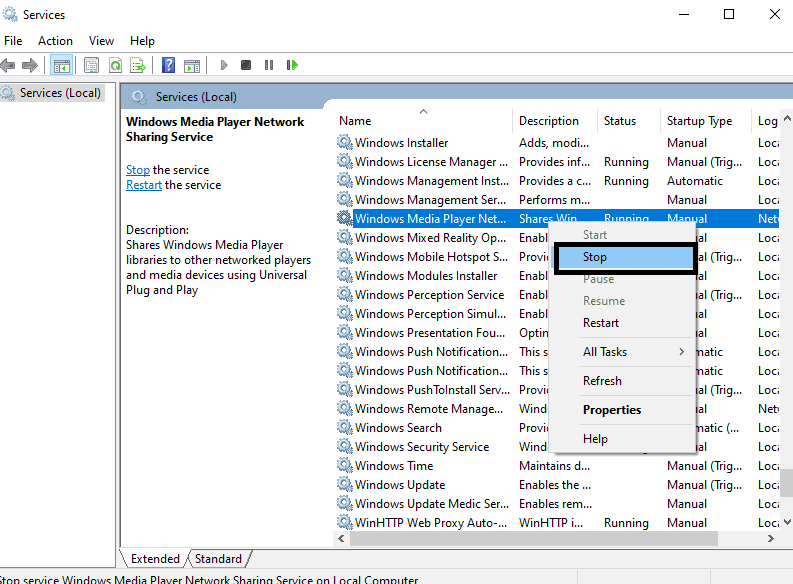
- Then restart the computer.
Now go back to the task manager window again and see if this process is still running. If you still see it running and taking up a lot of your memory and CPU, then move on to the next solution mentioned below.
Disable Automatic Startup of the Windows Media Player Network Sharing Service:
Terminating the service won’t solve the problem in computers that have the service enabled for starting up when the device boots up. After loading on the necessary windows services, the OS will load up processes like wmpnetwk.exe. So basically, this process will keep running in the background even when you are not using the Windows Media Player. So it would be best if you changed the service’s configuration to make it manually startup only when the network sharing service is enabled in the Windows Media Player. That is, you need to disable the automatic startup of the Windows Media Player Network Sharing Service.
- Press Windows + R, and it will open up the Run dialog box.
- Enter “services” in the dialog box and click on Ok.
- Now the Windows Services Manager window will show up. Here, look for the service “Windows Media Player Network Sharing Service.” Once you find it, right-click on it and choose Properties.
- In the properties window, stay in the General and look at the Startup type set for this service. Click on the drop-down box next to startup type and set it to Manual.
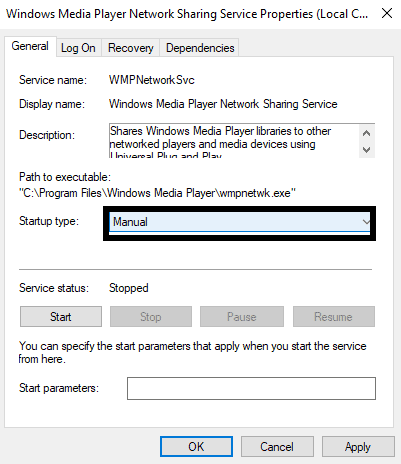
- Click on Apply and then click on Ok.
- Finally, restart your computer.
Now check your task manager again and check whether the wmpnetwk.exe process is gone or not. If it is still there, try the next solution mentioned below.
Disable Windows Media Player’s Network Sharing Service:
Not everyone uses the Windows Media Player. It is the default player on offer from Windows, and there is no way to uninstall it. So seeing the wmpnetwk.exe process taking up so much of the RAM and CPU is frustrating. Disabling the automatic startup and stopping the process are just temporary solutions. But if you are someone who can live without using the screen sharing functionality of the Windows Media Player, then you should disable it entirely. If you decide to use this feature in the future, you can enable it again.
- Press Windows + R, and it will open up the Run dialog box.
- Enter “services” in the dialog box and click on Ok.
- Now the Windows Services Manager window will show up. Here, look for the service “Windows Media Player Network Sharing Service.” Once you find it, right-click on it and choose Properties.
- In the properties window, stay in the General and look at the Startup type set for this service. Click on the drop-down box next to startup type and set it to Disabled.
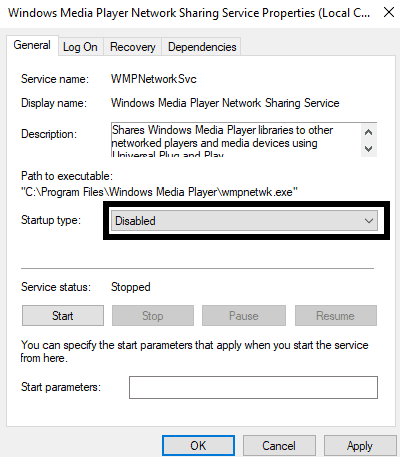
- Click on Apply and then click on Ok.
- Finally, restart your computer.
If you are still facing issues with this wmpnetwk.exe process eating up many of the PC’s resources, then go for the next solution mentioned below.
Disable Media Streaming:
If none of the solutions mentioned above worked for you, then disabling the media streaming entirely will definitely help with the wmpnetwk.exe process taking up so much of the RAM and CPU of the computer. This solution is perfect for those who don’t plan to stream any media files with other devices.
- Click on the Search bar and enter “Control Panel.”
- Once it shows up in the results, open it.
- Set the “View by” option in the top right corner of the control panel window as Category.
- Click on “Network and Internet.”
- Choose “Network and Sharing Center.”
- On the left, you will see “Media streaming options.” Click on it.
- Then, uncheck the “Allowed” box next to “Media programs on this PC and remote connections” and click on Ok. This will turn off media streaming on your computer.
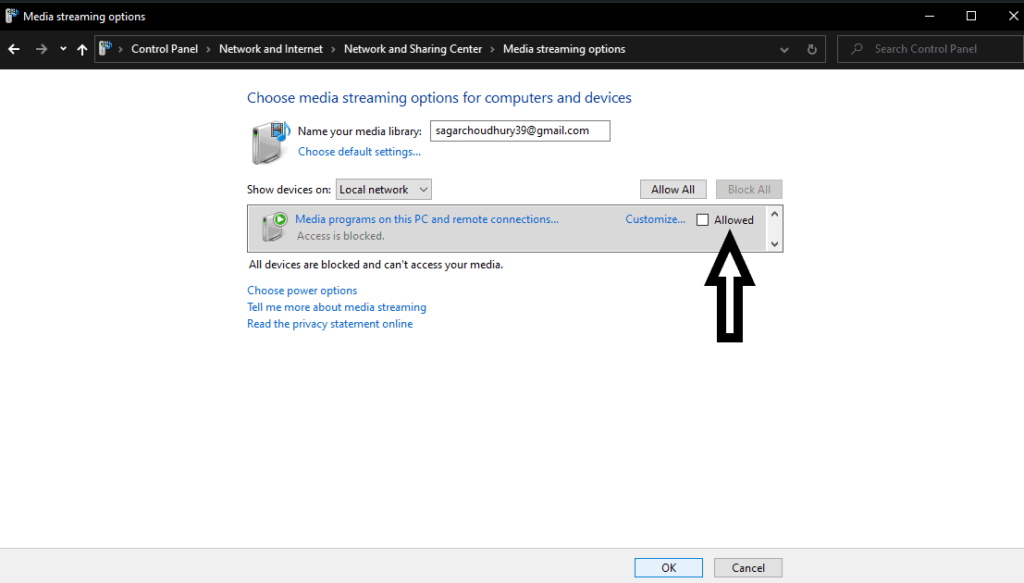
If even this does not solve your problem with the wmpnetwk.exe process file, go for the next potential solution mentioned below.
Disable/Uninstall the Windows Media Player:
The wmpnetwk.exe process is related to the Windows Media Player. And without the Windows Media Player on the computer, this particular wmpnetwk.exe process won’t be able to run at all.
- Click on the Search bar and enter “Control Panel.”
- Once it shows up in the results, open it.
- Set the “View by” option in the top right corner of the control panel window as Category.
- Click on “Programs.”
- Then choose “Programs and Features.”
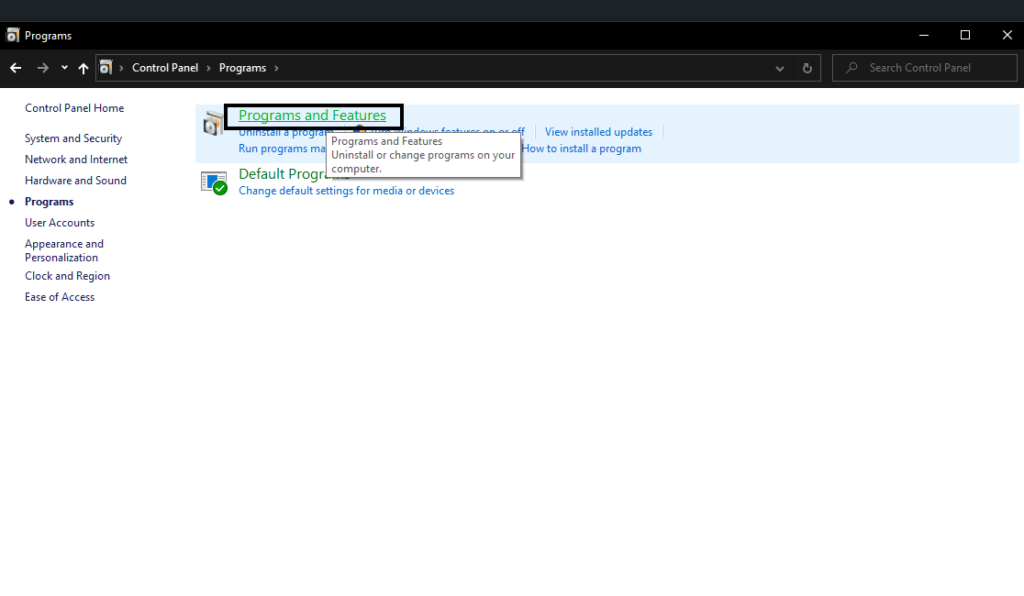
- On the left sidebar, you will see the option “Turn Windows features on or off.” Click on it.
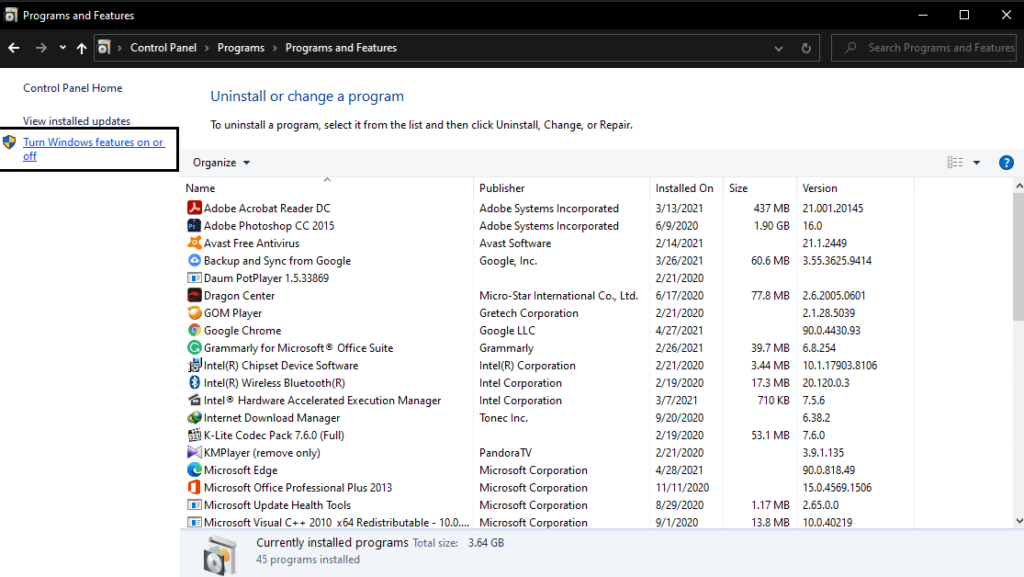
- A list will now appear. Here, look for the Media Feature folder. Once you find it, double-click on it to expand it. Here, you will find the Windows Media Player.
- Check the box next to “Windows Media Player” here and click on Ok.
- A pop-up will show up asking for your confirmation to disable the Windows Media Player entirely. Click on Yes here.
- Finally, restart your computer to save the changes.
After removing Windows Media Player, you will not see any resource drain issue with the wmpnetwk.exe process as the process won’t even be there to work in the background.
This is how one can fix wmpnetwk.exe high memory and CPU usage in Windows. If you have any questions or queries about this article, then comment down below, and we will get back to you. Also, be sure to check out our other articles on iPhone tips and tricks, Android tips and tricks, PC tips and tricks, and much more for more useful information.
